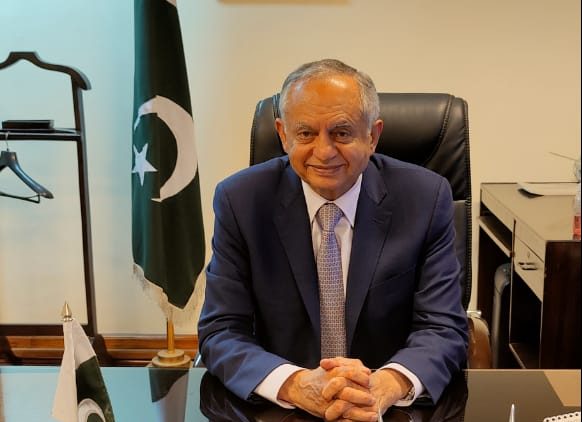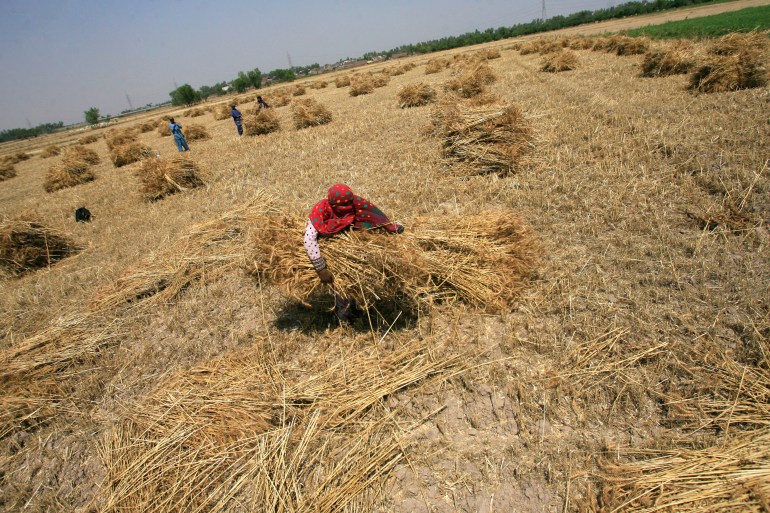Pakistan faces ‘hard choices’ for export growth: Commerce chief
To diversify exports beyond textiles, it’s offering firms a combination of incentives and pressure to step up exports.

ISLAMABAD, Pakistan – Pakistan’s government is targeting a trade deficit of $30bn in the current fiscal year, with new export-centric policies focused on reducing the country’s reliance on textiles and providing incentives to other sectors, the country’s top commerce official has said.
Textiles are the South Asian country’s major export, making up more than 60 percent of the country’s $25.3bn in exports last year, according to government data.
Keep reading
list of 4 itemsPakistan expands COVID vaccination drive amid Omicron fears
‘My world has collapsed’: Pakistan lynching victim buried
Pakistan places new restrictions amid rise in COVID cases
The sector continues to receive the lion’s share of government export sector subsidies, including subsidised energy, access to cheap credit for working capital and long-term capital expenditure and duty drawback concessions. This year, government subsidies to the textile sector have amounted to an estimated $780m, according to government data and industry estimates.
In the current fiscal year which ends in June, textile exports have risen by 26 percent, amounting to $9.38bn, according to the data.
Abdul Razaq Dawood, the Pakistani prime minister’s adviser for commerce and investment, told Al Jazeera in an interview that his ministry is working on policies to wean the economy off its dependence on textile exports, although incentives to the textile sector would also continue.
“We have to diversify our exports. We cannot rely on just textiles,” he said. However, he expects textiles to continue to be the major export “at least for the next five years.” The one sector he expects will eventually surpass textiles is information technology. “If it keeps growing at the same pace, then after five years … IT will start becoming our number one [export],” Dawood said.
Pakistani IT exports in the current fiscal year stand at $1.3bn, according to central bank data, an increase of 36 percent over the same period last year, but still just seven percent of overall exports.
Dawood said his government was targeting the pharmaceutical and engineering sectors as other areas of potential growth.
Pharmaceutical exports have shrunk by 0.66 percent to $137.98m this fiscal year so far, while engineered goods exports have risen by 7.5 percent to $109.23m, according to government data.
Ballooning trade deficit
Of more immediate concern to the government, however, may be the country’s ballooning trade deficit, which has more than doubled to $27.36bn so far this fiscal year, with a 24 percent increase in exports insufficient to offset a spiralling import bill, driven by high global commodity prices and a depreciation of the Pakistani rupee, among other reasons.
Commerce adviser Dawood is betting that bumper domestic wheat and sugar crops this season will help eliminate the imports of those foods.
“Yes, there is pressure on our trade balance right now,” he said, adding that he expected it to “come down” by March.

Trade analysts, however, question Dawood’s predictions.
“The optimism regarding wheat output, at least at this point in time, is unsubstantiated,” on account of a shortage and steep price rise in fertilisers, said Adil Mansoor, policy and research analyst at the Karachi-based Business Recorder publication and research house.
“It is too early to predict that Pakistan will not need to import wheat during 2022, especially in the context of heightened smuggling risk to Afghanistan,” he said, referring to past incidents when Pakistan’s wheat was smuggled to its northwestern neighbour, especially when the domestic price was low.
Pakistan imported wheat and sugar worth $1.1bn last year and for $659.74m so far this year.
Dawood said he expected a trade gap of “about $30bn” by the end of the fiscal year.
Gonzalo Varela, senior economist at the World Bank’s Pakistan office, said making that target will be tough, “although not impossible”.
“There are three factors playing a role in how large the trade deficit will be by the end of this [financial year]: commodity prices, exchange rates, and GDP growth in the world and in Pakistan,” he told Al Jazeera.
Cheap credit and subsidies
The success of Dawood’s call for “an export-driven growth strategy” will depend on how successful government incentives to export-oriented sectors turn out to be. So far, the textile sector, the country’s largest export, has been the main beneficiary of many of those programmes which include $481m in subsidised natural gas and electricity.
The energy subsidies were subject for debate in the federal cabinet in late December, as the cash-strapped government implemented wide-ranging budget cuts and introduced new taxes and hiked existing ones to save the country roughly $1.9bn, ahead of an International Monetary Fund review of its $6bn bailout programme.
Dawood contended that the government needed to make “hard choices” to prioritise export industries, despite the deep budget cuts elsewhere.
“You have no choice. Cut your expenses elsewhere, and put that into subsidising our exports,” he said. “Everyone obviously wants to protect his own turf, but [that] is the decision of the prime minister.”
On December 28, the government approved an extension for energy subsidies for the short-term under which it increased the rate of subsidised gas to export-oriented sectors by 38 percent, but kept the price of the subsidised electricity unchanged.
The textile sector also benefits from cheap credit offered to export-facing industries in the form of the Export Finance Scheme (EFS) and the Long-Term Finance Facility for Plant & Machinery (LTFF), which provides loans for working capital and long-term capital expenditure, respectively, at rates far below the current policy rate of 9.75 percent.
Analysts say those credit incentive schemes need to be modified.
“The evaluation of the credit schemes reveals that while they are impactful in increasing exports,… the schemes are very costly to run,” said the World Bank’s Varela. “Particularly the EFS, that finances working capital: For every extra dollar exported because of subsidised credit through EFS, [the central bank] ‘pays’ 83 cents.”
The equivalent for LTFF loans, Varela said, was 8 cents per extra export dollar.

Business Recorder analyst Mansoor, says that the cheap credit schemes benefit only a small subset of export firms. Of the roughly 15,000 exporters, only 800 benefit from export refinance schemes.
“The problem with EFS, in my opinion, is that only large and very few companies benefit,” he said. “If it works, it needs to be expanded to a lot more people if the government is truly focused on export-led growth.”
World Bank’s Varela added that the government’s export incentives need to be “time-bound” to be sustainable.
“When the sunset clause of the support is not clear, firms start allocating valuable resources in ensuring incentives and subsidies remain, rather than into ensuring their productivity grows,” he said. “That makes incentives and subsidies unsustainable in the long term.”
Mansoor agreed, saying the current set of subsidies, including EFS and other incentives, had created the risk of dependency on the government. “The export growth only happens when subsidies are extended. That’s a big if: Can they stand on their own legs once these concessions are removed?”
‘Get ready for exporting’
For now, commerce adviser Dawood is focused on encouraging export-oriented sectors, particularly to new markets in Africa and Central Asia, in products that are not “traditional” Pakistani exports, including pharmaceuticals, engineered products, and chemicals.
“Our non-traditional markets, the main ones at this moment are Africa and the Central Asian republics,” he said. “Those are the areas that we are really getting into.”
To encourage that, the government is currently offering a financial incentive as a percentage of invoice values for firms to export to such markets.
The government also plans to trim taxes on finished goods that Pakistan imports. Those taxes were introduced to push the local industry towards manufacturing, but businesses are now unwilling to export as they have an easy domestic market. That will have to change if Islamabad is to meet its export goals.
“I think we are now ready. ‘OK fellas,’ I used to say to them: ‘Look I am giving you this additional profitability, get your production, get to a critical mass so that you can get ready for exporting.’”
Some of the sectors where the government will start rolling back taxes include iron and steel products, electric fans, engineering products and certain chemicals, Dawood said.
Analysts, however, say progress on that front has been very slow.
“This FY22 budget indeed brought about a small reduction on import duties on finished goods, but extremely timid,” said the World Bank’s Varela. “In the long term gradually reducing import duties on finished goods is the way to reduce the anti-export bias that Pakistan’s import duty structure has.”